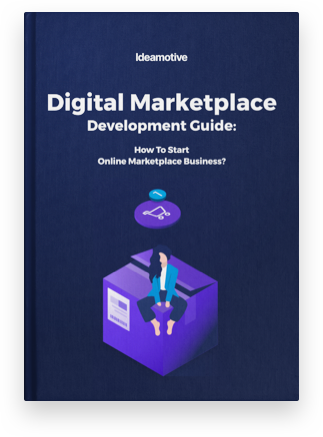It is absolutely clear that a marketplace business model can generate more than satisfying revenue for its owner. But first, one fundamental question must be asked: what is the best way to make money in a particular case? Let’s look at the most popular marketplace financial models.
If you look at the best-known marketplaces such as Amazon, eBay, Airbnb, or Uber, you quickly notice one thing they all have in common. They are giant and profitable companies, well-known all around the world and gathering hundreds of thousands of vendors as well as customers or users. But if you think about marketplace development, you don’t necessarily set these brands as your benchmark. You would instead seek smaller marketplaces, much closer to your business capabilities and ambitions. Yet, when you analyze their financial Google sheets, you conclude that no matter the scale, all (or the overwhelming majority) marketplaces have implemented very similar solutions.
Therefore, there is no need to reinvent the wheel when it comes to balancing your expenditure and income. Instead, you should rather operate on one of the tested, trusted, and existing internet marketplace business model. No matter if you plan to launch a product-based or service-based marketplace, the solution for you is probably already waiting for you.
Now it is time for in-depth analysis for such business models as commission, subscriptions, and so on to find out how do online marketplaces make money.
Commission Model
This could be called the most popular marketplace payment model if such opinion would be based on comparison how big brands use it for their everyday operations: Airbnb, Amazon, eBay, Etsy, and Uber are the best-known marketplaces with commission model. The basic rule defining it is that marketplace owner or manager receives previously agreed on part of the transaction that is done at an internet platform.
Logically, if there is no transaction, then there is no money for marketplace owner. Users meant here as physical persons or companies providing products or services to the platform, as well as final customers looking for offer do not have to pay for their activity. Platform admin has excellent variety in shaping the marketplace payments. Charging may be dependent on the value of the transaction, the number of transactions in any period or on the number of products sold.
Such flexibility is undoubtedly one of the pros of this marketplace financial model. Another one is its simplicity and clarity. Once the rules for calculating transaction share are set, they can be easily followed. Algorithms can immediately precisely estimate the amount of money that should be paid to marketplace owner. The risk of complaints or arguments between admin and vendors or customers is minimalized.
The challenges which must be addressed in this model are mainly focused on fiscal issues. Flat fee or percentage on the transaction or maybe both? What should be the frequency of splitting a commission with users? How to differentiate fees between various products, services, or even vendors. A serious obstacle is an inability to predict the number of profits as it may visibly vary in the following periods.
Melltoo is an excellent example of a marketplace with a commission model. As they underline, “we only make money if you sell,” what elegantly explains this model. Then they add, “so our job is to help you sell,” which pretty comprehensively explains the duties of every manager owning platform that uses this marketplace financial model.
Subscription Model
Contrary to the commission model, this example here gives quite reliable insight on what revenue could be generated in a month, quarter, or even a whole year. This happens because data needed for calculating profits is available: number of current members (vendors, clients), the potential number of future members, and membership fees. Maybe because of this predictability, the subscription model is attracting the attention of many marketplace owners.
In this model, the marketplace owner receives money from registered users on a regular basis. Price for membership may be varied: the more exclusive membership with more options available, the more expensive. The users are usually acquired for a longer time. It is equal with smaller spending on marketing, retargeting, and social media campaigns set to activate marketplace users as they are already spending money on a membership. Instead, the marketing budget may be utilized for attracting new users.
The greatest challenge of this marketplace financial model is balancing the membership plan. If fees would be too high, people may not be attracted to a given marketplace. On the other hand, too low price could limit admin’s profits while favoring members and giving them too many benefits.
There are some interesting case studies from the beauty industry: members of such platforms as Cratejoy receive boxes consisting of beauty, health, and interior products delivered by renowned brands. Content of such box depends on the membership fee.
Listing Fee Model
Instead of charging users for signing, a different marketplace financial model can be chosen. Users may have to pay marketplace owner for listing products or services. It is quite a transparent payment option as the marketplace has own strictly defined stakes for multiple products. All users have access to the same information and have to pay the same amount of money for goods or services they offer. They are treated equally and feel that the marketplace plays fair.
The most positive effect of listing fee model is that simultaneously with the growth of the marketplace – defined here as the increase in the number of listed goods – its admin is earning more money. It should be noted that the listing fee model may directly improve the quality of the marketplace offer. Users, knowing that they are obliged to pay for any item they wish to sell, do it wisely and automatically try to adjust to customers’ needs. As a result, such a marketplace is steadily gaining approving opinions as people are aware that they probably would find what they are looking for.
But there are some minuses of listing fee monetization model. If the stakes are chosen wrongly and are too low, the platform may attract spammers. Contrary, if they are too high, people would be discouraged from placing any products at all. Results are easy to predict: marketplace will stop to grow.
Delivery Hero is one of the numerous marketplaces that have adopted listing fee model. Its owners and team of managers are actively experimenting with binding fees, trying to optimize it. And judging by Delivery Hero current market position, their efforts bring positive effects.
Lead fee
A lead fee means charging users a commission per lead. It is also a great way of improving your project’s balance sheet. For example, sellers can pay for each customer that contacts them. You can charge for each interest or just for leads that convert. An email, call, website visit, or other interaction can be considered a potential customer.
Lead fees fall somewhere between listing fee and commission models. In the typical pay-per-lead model, customers place requests on a site and vendors pay to place a bid for those customers. This model provides a better value proposition than the listing fee model: you only pay when you connect with a potential customer.
This revenue model delivers tangible benefits to users as suppliers connect with real buyers who are interested in making deals. With lead commissions, there is less risk of sellers wasting money than investing in advertising.
However, marketplace users may want to find ways to contact buyers directly, especially if the commission is high. This is where competitive and dynamic pricing and stringent auditing rules can help.
If you are using a contract or service based marketplace, this method may be the best for you. The pay-per-lead approach is often used in B2C or B2B service platforms, where each new lead can lead to long-term customer relationships with multiple deals.
Thumbtack, an online service that helps clients meet local professionals, charges fees for leads. It is almost impossible to calculate the price of a specific service for users, so a commission model is out of the question - in this case, the lead commission approach works best. Undoubtedly, Thumbtack has no issues with their cash flow statement thanks to this method.
Freemium
This model goes by several different names, including value-added services and advanced merchant services. Whatever you call it, it means you are offering a "freemium" plan for all users and offering additional features to merchants for a fee.
The logic behind the freemium model is that once your users are connected to your core services, you offer paid features that are so beneficial that many customers agree to pay.
A key benefit of the freemium model is that it takes a lot less effort to drive an audience to the free marketplace, which means more people will visit your platform than if you were using the membership model.
Apart from one additional point added to your fixed expenses, this method puts on top another challenge. Your paid services must be valuable enough to attract a significant portion of your users. If very few people are interested in what you are offering, you will not have a strong business model. A marketplace can solve this problem by offering shipping benefits and exclusive shopping options.
The freemium model is a good choice if you are just starting your marketplace. This model can complement others such as featured listings and advertisements (see this model below).
Peerby is a Dutch startup that operates an exchange service. It's mostly free, but there are two paid offers: insurance and shipping.
Featured listings and ads
When asked what is the best business plan for marketplaces, we cannot ignore this model. Featured Lists and Ads are ways that providers can increase the visibility of their offerings.
To make a product or service more accessible, you can post vendor and product profiles on the home page and include sponsored products on other product pages.
Provided you operate in a highly competitive market and your platform is well known, paid listings and ads can generate significant profits for you.
As customers increasingly distrust ads, convincing them to buy a particular product or service can be challenging. Featured listings and ads should be of good quality and not intrusive. Also, it's best not to promote low-quality products as it can hurt the customer experience.
Featured listings and ads work best as an additional monetization method if you've already earned your place in the sun.
An example of this model is Gumtree, the UK's most popular classifieds site. Etsy provides featured lists as one of its premium services.
This marketplace business model is relatively close to pure advertising models - where you serve ads (like Google Adsense) to your users. This marketplace business model is relatively close to pure advertising models - where you serve ads (like Google Adsense) to your users. Featured lists and ads are popular sources of income for classified ads sites. They can often be seen on real estate markets (like Zillow) or free exchange platforms (like Freecycle).
Newegg, an online retailer of goods including computer hardware and consumer electronics is another great example. It runs a variety of advertisements on its landing page.
As you may see, the majority of existing marketplaces have utilized one of the aforementioned marketplace payments and optimized it. They may vary in smaller or bigger details. However, the general rules are the same.
Which marketplace business model should you choose
There is no need to limit yourself to a specific marketplace business model. Large market companies successfully combine two or more strategies such as Amazon or Etsy.
You can determine the best monetization method for your marketplace based on your income statement, platform type, level of competition, business goals and revenue strategy.
The commission model is the most popular way to better your cash flow statement as it is attractive to market participants. However, in some cases it does not work, for example, when transactions are made for very large amounts.
If you wish to consult your monetization strategy for your marketplace, contact us. We will be more than happy to analyze your ideas for marketplace business and give you some expert feedback using Google sheets, as well as help in finding the ultimate answers to the questions of how do online marketplaces make money and the best way to better your balance sheet.









